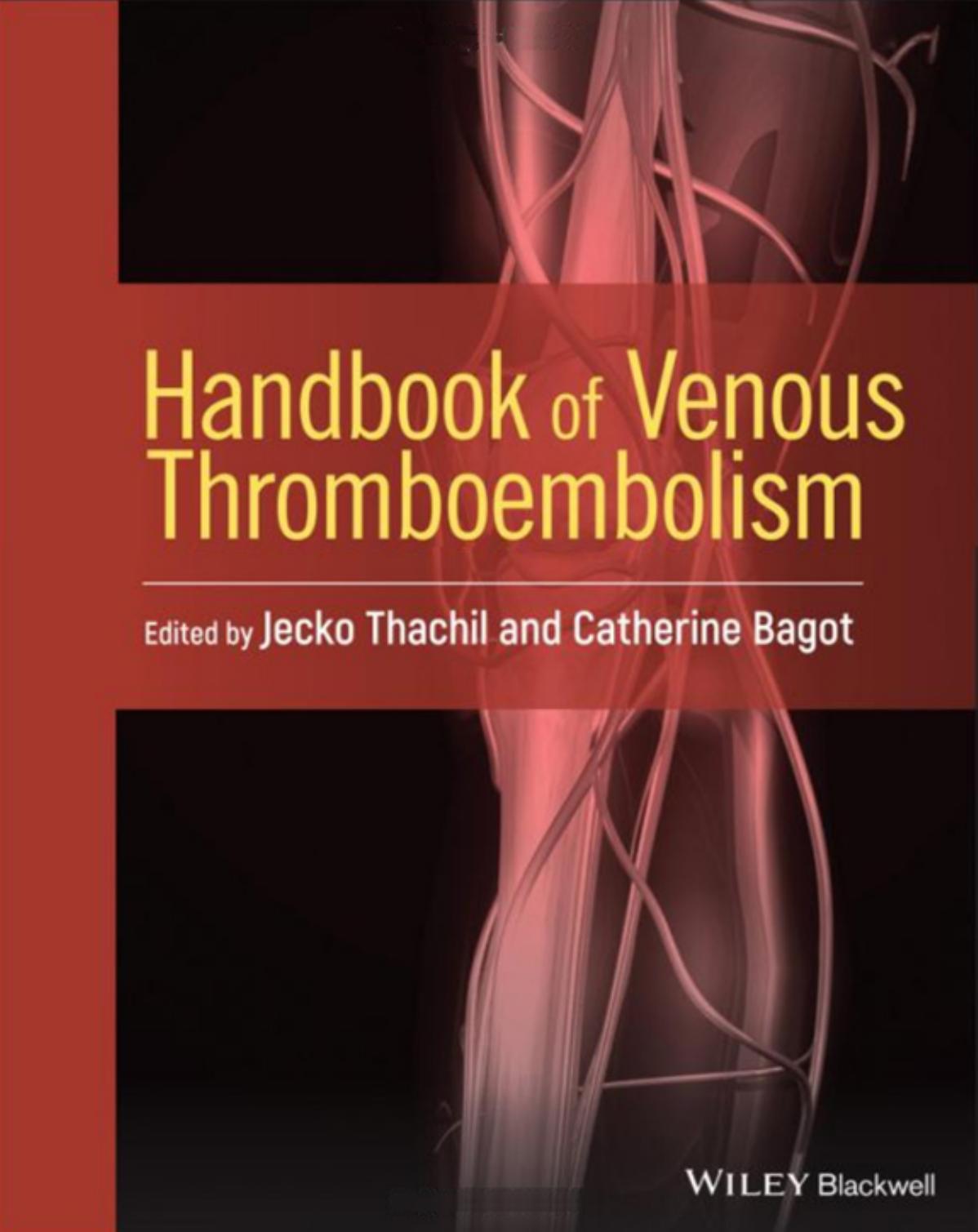Handbook of Venous Thromboembolism 1st edition by Jecko Thachil, Catherine Bagot 1119095573 9781119095576
$70.00 Original price was: $70.00.$35.00Current price is: $35.00.
Instant download Handbook of Venous Thromboembolism after payment
Instant download Handbook of Venous Thromboembolism pdf, docx, kindle format all chapters after payment. 1119095573, 9781119095576

Product details:
A clinically oriented handbook providing up-to-date recommendations for mastering the practical aspects of patient management for venous thromboembolism
Venous thromboembolism (VTE) is associated with high morbidity and mortality both in and out of the hospital setting, and is one of the commonest reasons for hospital attendances and admissions. Designed as a practical resource, the Handbook of Venous Thromboembolism covers the practical aspects of venous thromboembolism management in short and easily followed algorithms and tables. This important text helps physicians keep up-to-date with the latest recommendations for treating venous thromboembolism in clinic-oriented settings. Experts in fields such as the radiological diagnosis of pulmonary embolism and thrombophilia testing, give a succinct summary of the investigation, diagnosis and treatment of venous thromboembolism and include evidence-based guidelines.
With contributions from a team on internationally recognized experts, Handbook of Venous Thromboembolism is a source of information that specialists in the field can recommend to non-specialists and which the latter will be able to review to assist in their education and management of this wide-spread condition. This vital resource:
- Comprises of a clinically focused handbook, useful as a daily resource for the busy physician
- Offers a handbook written by an international team of specialists offering their experience on the practical aspects of venous thromboembolism management
- Addresses venous thrombosis prevention, a major focus for healthcare providers
- Includes coverage on controversies in the management of venous thromboembolism so clinicians can understand how experts are practicing in real scenarios
Written for hematology trainees, emergency and acute medicine physicians, junior doctors, and primary care physicians, Handbook of Venous Thromboembolism covers the basics for treating patients with venous thromboembolism and offers guidelines from noted experts in the field.
Table of contents:
Section I: Clinical Overview
1 Risk Factors for Venous Thromboembolism
Introduction
Previous VTE
Surgery
Hospitalised Medical Patients
Cancer Associated Thrombosis (CAT)
Pregnancy
Combined Oral Contraceptive Use
Family History of VTE and Thrombophilia
Obesity
Travel
Substance Abuse
Conclusion
Further Reading
2 Management of Venous Thrombosis in the Lower Limbs
Introduction
Diagnosis
Treatment
Further Reading
3 Clinical Presentation of Acute Pulmonary Embolism
Introduction
Symptoms of Acute PE
Clinical Signs of Acute PE
Differential Diagnosis
Clinical Presentation in Specific Patient Subgroups
Clinical Presentation and Associated Prognosis
Summary
Further Reading
Section II: Diagnosis
4 Clinical Prediction Scores
Pulmonary Embolism
Deep Vein Thrombosis
Potential Pitfalls
Key Reading
5 Laboratory Aspects in Diagnosis and Management of Venous Thromboembolism
Introduction
Laboratory Diagnostics of Venous Thromboembolism
Laboratory Prediction of Recurrent Venous Thromboembolism
Laboratory Monitoring of Anticoagulant Therapy
References
6 Thrombophilia Testing
Introduction
Inherited Risk Factors
Acquired Risk Factors
Mixed Risk Factors
Indications for Thrombophilia Testing
Further Reading
7 Radiological Diagnosis of Pulmonary Embolism
Introduction
Ventilation‐perfusion Scanning (V/Q Scintigraphy)
Spiral Computed Tomography Pulmonary Angiography (CTPA)
The Issue of Subsegmental PE
Haemodynamic Assessment of Patients with PE
Latest Trends
Cost‐effectiveness
Summary
References
8 The Antiphospholipid Syndrome
Antiphospholipid Antibodies: Epidemiology and Antigenic Specificities
Thrombosis
Management of APS
Management of Pregnancy
Management of Catastrophic APS
Review Articles
Guidelines
References
Section III: Treatment
9 Inpatient or Outpatient Anticoagulation
Introduction
Deep Vein Thrombosis
Pulmonary Embolism
Sub‐segmental Pulmonary Embolism
The Importance of a VTE Clinic
Cost‐effectiveness
Summary
Further Reading
10 An Anticoagulant Service in Practice
History
Current Organisation
Referral Process
Induction Appointments
Hospital Discharge Patients
Anticoagulant Clinic Structure
Self‐testing Patients
Direct Oral Anticoagulants (DOACs)
The Future of GCAS
Further Reading
11 Point of Care Testing
International Normalised Ratio (INR)
Quality Control
Comparison with Laboratory Results
Limitations of POC devices
POC D‐dimer tests
Key Learning for POC INR Testing
Further Reading
12 Direct Oral Anticoagulants in the Prevention and Management of Venous Thromboembolism
DOACs in treatment and prevention of Venous Thromboembolism: Introduction
Oral Direct Thrombin Inhibitors
Oral Xa Inhibitors
Systematic reviews and meta‐analyses of DOACs
Practical Issues for DOAC Usage
DOAC use in Specific Patient Subgroups
Further Reading
13 The Role of Thrombolysis in the Management of Venous Thromboembolism
Introduction
Rationale Behind CDT for Acute DVT
Pre‐procedural Evaluation and Indications
Contraindications
Technical Aspects of CDT
CDT Pros and Cons
Outcomes for CDT in DVT
Thrombolysis in Pulmonary Embolism
Upper Extremity DVT
Further Reading
References
14 Inferior Vena Cava Filters in the Management of Venous Thromboembolism
Introduction
Evidence for IVCFs
Complications of IVCFs
IVCF Retrieval
IVCFs and Anticoagulation
Specific Indications for IVCF Placement
IVCF for Primary PE Prophylaxis
Conclusion
Further Reading
Disclosures
References
Section IV: Special Situations
15 VTE in Pregnancy
Introduction
Incidence
Normal Physiological Changes of Pregnancy
Risk Factors
Thrombophilias
VTE Prophylaxis in Pregnancy
Diagnosis of VTE in pregnancy
Management
IVC Filters
VTE in Unusual Sites
Thrombophilia Screening
Massive PE/thrombolysis
Thrombolysis for PE in Pregnancy
Post‐thrombotic Syndrome
Follow‐up
Further Reading
16 Paediatric Venous Thromboembolism
Incidence
Paediatric Pathophysiology
Risk Factors
Clinical Manifestations
Diagnosis
Treatment
Treatment Recommendations
Complications
Post‐thrombotic Syndrome (PTS)
Follow‐up
Further Reading
17 Cancer‐associated Thrombosis
Introduction
Pathophysiology of Cancer‐associated Thrombosis
The Psychological Impact of CAT
Diagnosis of CAT
Challenges in the Management of CAT
Initial Treatment
Long‐term Anticoagulation
Challenging Cases
Use of Inferior Vena Cava Filters
Thromboprophylaxis in Hospitalised Cancer Patients
Thromboprophylaxis in Ambulant Cancer Patients Receiving Chemotherapy
Conclusion
Further Reading
18 Venous Thromboembolism Management in Obese Patients
Challenges of VTE Diagnosis
Treatment of VTE
Drugs Where Recognised Therapeutic Drug Monitoring Overcomes the Challenges of any Changes That Obesity May Have on Drug Pharmacokinetic Profiles
Direct Oral Anticoagulants (DOACs)
Further Reading
19 Venous Thromboembolism in Intensive Care
Introduction
Incidence
Diagnosis
Thromboprophylaxis or Not?
Mechanical Thromboprophylaxis
Treatment of Venous Thromboembolism in the Critically Ill
Conclusion
Further Reading
20 Venous Thromboembolism; a Primary Care Perspective
Introduction
Prevention
References
Section V: Unusual Site Thrombosis
21 Cerebral Venous Thrombosis
Aetiology
Pathophysiology
Clinical Presentation
Diagnosis
Treatment
Secondary Prevention in Patients at Risk
Prognosis
Suggested Further Reading
Financial Disclosure
References
22 Upper Extremity Thrombosis
Overview
Background and Classification
Epidemiology and Risk Factors
Prevention
Diagnosis
Approach to the Diagnosis of Suspected UEDVT
Interventional and Endovascular Therapies
Surgical Treatment
Management of CVC/PICC Devices with UEDVT
Prognosis and Complications
References
23 Management of Intra‐abdominal Thrombosis
Splanchnic Vein Thrombosis
Renal Vein Thrombosis
Ovarian Vein Thrombosis
Further Reading
References
24 Thrombosis in the Retinal Circulation
Introduction
Basic Eye Anatomy
Retinal Vein Occlusion
Retinal Artery Occlusion
Conclusions
Further Reading
Conflicts of Interest/disclosures
References
Section VI: Long‐term Sequelae of VTE
25 Post‐thrombotic Syndrome
Introduction
Pathophysiology
Signs and Symptoms
Risk Factors for Developing PTS
Quality of Life
Scoring Systems
Investigations
Treatment
Prevention Strategies
Further Reading
26 Chronic Thromboembolic Pulmonary Hypertension
Introduction
Epidemiology
Pathophysiology
Clinical Presentation and Patient Evaluation
Treatment
Summary
Further Reading
Bibliography
27 Predicting Recurrent VTE
Factors Influencing Risk of Recurrent VTE
Clinical Prediction Rules for Recurrent VTE
Conclusions
Further Reading
Section VII: Controversies
28 Cancer Screening in Unprovoked Venous Thromboembolism
Further Reading
29 Sub‐segmental and Incidental PE – to Treat or Not?
Introduction
Definitions
Who Gets Incidental/Subsegmental PE?
The Issue of Sub‐segmental PE
Management Approach to Incidental/Sub‐segmental PE
Conclusion
Further Reading
30 Management of Distal Vein Thrombosis
Diagnosis of Distal Deep‐vein Thrombosis
Treatment of Isolated Distal Deep‐vein Thrombosis
References
Section VIII: Prevention
31 A Summary of the Evidence for VTE Prevention, with a Focus on the Controversies
Introduction
Hospitalised Patients
Further Reading
32 VTE Prevention: Real World Practice
The Strategy
Risk Assessment
Appropriate Thromboprophylaxis (TP)
Further Reading
33 VTE Root Cause Analysis – How To Do It
Background
RCA Goes Political; the English Experience
People also search:
handbook of venous and lymphatic disorders
venous thromboembolism guidelines
chest guidelines venous thromboembolism
hematology vte guidelines
prevention of venous thromboembolism guidelines


